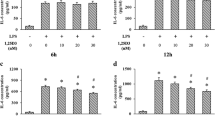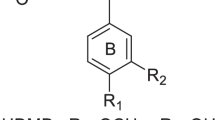Abstract
Honokiol and magnolol, which are lignans isolated from Magnolia quinquepeta, have some pharmacological effects. However, the anti-inflammatory effects of honokiol and magnolol on periodontal disease are still uncertain. The aim of this study was to examine the effect of honokiol and magnolol on CXC chemokine receptor 3 (CXCR3) ligands, which are related with Th1 cell migration, production in interleukin (IL)-27-stimulated human oral epithelial cells (TR146 cells). Honokiol and magnolol inhibited CXC chemokine ligand (CXCL)10 and CXCL11 production in IL-27-stimulated TR146 cells in a dose-dependent manner. Moreover, we revealed that honokiol and magnolol could suppress signal transducer and activator of transcription (STAT)3 and protein kinase B (Akt) phosphorylation in IL-27-stimulated TR146 cells though STAT1 phosphorylation was not suppressed by honokiol and magnolol treatment. Furthermore, STAT3 and Akt inhibitors could suppress CXCR3 ligand production in TR146 cells. In summary, honokiol and magnolol could reduce CXCR3 ligand production in oral epithelial cell by inhibiting STAT3 and Akt activation.





Similar content being viewed by others
References
Lee, Y.J., Y.M. Lee, C.K. Lee, J.K. Jung, S.B. Han, and J.T. Hong. 2011. Therapeutic applications of compounds in the Magnolia family. Pharmacology & Therapeutics 130: 157–176.
Xu, H.L., W. Tang, G.H. Du, and N. Kokudo. 2011. Targeting apoptosis pathways in cancer with magnolol and honokiol, bioactive constituents of the bark of Magnolia officinalis. Drug Discoveries &Therapeutics 5: 202–210.
Amorati, R., J. Zotova, A. Baschieri, and L. Valgimigli. 2015. Antioxidant activity of magnolol and honokiol: kinetic and mechanistic investigations of their reaction with peroxyl radicals. The Journal of Organic Chemistry 80: 10651–10659.
Amblard, F., B. Govindarajan, B. Lefkove, K.L. Rapp, M. Detorio, J.L. Arbiser, and R.F. Schinazi. 2007. Synthesis, cytotoxicity, and antiviral activities of new neolignans related to honokiol and magnolol. Bioorganic & Medicinal Chemistry Letters 17: 4428–4431.
Fu, S., C. Sun, X. Tao, and Y. Ren. 2012. Anti-inflammatory effects of active constituents extracted from Chinese medicinal herbs against Propionibacterium acnes. Natural Product Research 26: 1746–1749.
Hajishengallis, G. 2014. Immunomicrobial pathogenesis of periodontitis: keystones, pathobionts, and host response. Trends in Immunology 35: 3–11.
Kawai, T., R. Eisen-Lev, M. Seki, J.W. Eastcott, M.E. Wilson, and M.A. Taubman. 2000. Requirement of B7 costimulation for Th1-mediated inflammatory bone resorption in experimental periodontal disease. Journal of Immunology 164: 2102–2109.
Taubman, M.A., and T. Kawai. 2001. Involvement of T-lymphocytes in periodontal disease and in direct and indirect induction of bone resorption. Critical Reviews in Oral Biology and Medicine 12: 125–135.
Hosokawa, Y., I. Hosokawa, K. Ozaki, and T. Matsuo. 2017. IL-27 modulates chemokine production in TNF-α-stimulated human oral epithelial cells. Cellular Physiology and Biochemistry 43: 1198–1206.
Han, J.J., M.P. Liu, Y. Jin, D.X. Liu, X. Fang, and X.P. Lin. 2013. Comparison of the IL-27 level in gingival crevicular fluid of cross-quadrant and the upper and lower half-mouth subgingival scaling. Shanghai Kou Qiang Yi Xue 22 (4): 428–431.
Jacobsen, J., E.B. Nielsen, K. Brøndum-Nielsen, M.E. Christensen, H.B. Olin, N. Tommerup, and M.R. Rassing. 1999. Filter-grown TR146 cells as an in vitro model of human buccal epithelial permeability. European Journal of Oral Sciences 107: 138–146.
Diegelmann, J., T. Olszak, B. Göke, R.S. Blumberg, and S. Brand. 2012. A novel role for interleukin-27 (IL-27) as mediator of intestinal epithelial barrier protection mediated via differential signal transducer and activator of transcription (STAT) protein signaling and induction of antibacterial and anti-inflammatory proteins. The Journal of Biological Chemistry 287: 286–298.
Valverde, P., T. Kawai, and M.A. Taubman. 2004. Selective blockade of voltage-gated potassium channels reduces inflammatory bone resorption in experimental periodontal disease. Journal of Bone and Mineral Research 19: 155–164.
Hosokawa, I., Y. Hosokawa, S. Shindo, K. Ozaki, and T. Matsuo. 2016. Melatonin inhibits CXCL10 and MMP-1 production in IL-1β-stimulated human periodontal ligament cells. Inflammation 39: 1520–1526.
Hosokawa, Y., I. Hosokawa, K. Ozaki, H. Nakae, and T. Matsuo. 2010. TNFSF14 coordinately enhances CXCL10 and CXCL11 productions from IFN-gamma-stimulated human gingival fibroblasts. Molecular Immunology 47: 666–670.
Hosokawa, Y., I. Hosokawa, S. Shindo, K. Ozaki, and T. Matsuo. 2017. IL-29 enhances CXCL10 production in TNF-α-stimulated human oral epithelial cells. Immunological Investigations 46: 615–624.
Ho, K.Y., C.C. Tsai, C.P. Chen, J.S. Huang, and C.C. Lin. 2001. Antimicrobial activity of honokiol and magnolol isolated from Magnolia officinalis. Phytotherapy Research 15: 139–141.
Lu, S.H., R.Y. Huang, and T.C. Chou. 2013. Magnolol ameliorates ligature-induced periodontitis in rats and osteoclastogenesis: in vivo and in vitro study. Evidence-based Complementary and Alternative Medicine 2013: 634095.
Cao, J., C.K. Wong, Y. Yin, and C.W. Lam. 2010. Activation of human bronchial epithelial cells by inflammatory cytokines IL-27 and TNF-alpha: implications for immunopathophysiology of airway inflammation. Journal of Cellular Physiology 223: 788–797.
Rajendran, P., F. Li, M.K. Shanmugam, S. Vali, T. Abbasi, S. Kapoor, K.S. Ahn, A.P. Kumar, and G. Sethi. 2012. Honokiol inhibits signal transducer and activator of transcription-3 signaling, proliferation, and survival of hepatocellular carcinoma cells via the protein tyrosine phosphatase SHP-1. Journal of Cellular Physiology 227: 2184–2195.
Yu, C., Q. Zhang, H.Y. Zhang, X. Zhang, X. Huo, E. Cheng, D.H. Wang, J.L. Arbiser, S.J. Spechler, and R.F. Souza. 2012. Targeting the intrinsic inflammatory pathway: honokiol exerts proapoptotic effects through STAT3 inhibition in transformed Barrett’s cells. American Journal of Physiology. Gastrointestinal and Liver Physiology 303: G561–G569.
Kim, B.H., and J.Y. Cho. 2008. Anti-inflammatory effect of honokiol is mediated by PI3K/Akt pathway suppression. Acta Pharmacologica Sinica 29: 113–122.
Kim, K.M., N.S. Kim, J. Kim, J.S. Park, J.M. Yi, J. Lee, and O.S. Bang. 2013. Magnolol suppresses vascular endothelial growth factor-induced angiogenesis by inhibiting Ras-dependent mitogen-activated protein kinase and phosphatidylinositol 3-kinase/Akt signaling pathways. Nutrition and Cancer 65: 1245–1253.
Lee, D.H., M.J. Szczepanski, and Y.J. Lee. 2009. Magnolol induces apoptosis via inhibiting the EGFR/PI3K/Akt signaling pathway in human prostate cancer cells. Journal of Cellular Biochemistry 106: 1113–1122.
Chen, S.C., Y.L. Chang, D.L. Wang, and J.J. Cheng. 2006. Herbal remedy magnolol suppresses IL-6-induced STAT3 activation and gene expression in endothelial cells. British Journal of Pharmacology 148: 226–232.
Chilampalli, C., R. Guillermo, X. Zhang, R.S. Kaushik, A. Young, D. Zeman, M.B. Hildreth, H. Fahmy, and C. Dwivedi. 2011. Effects of magnolol on UVB-induced skin cancer development in mice and its possible mechanism of action. BMC Cancer 11: 456.
Funding
This work was supported by JSPS KAKENHI (Grant Numbers: 16K11834 and 18K09600).
Author information
Authors and Affiliations
Corresponding author
Ethics declarations
Conflict of Interest
The authors declare that they have no conflict of interest.
Rights and permissions
About this article
Cite this article
Hosokawa, Y., Hosokawa, I., Ozaki, K. et al. Honokiol and Magnolol Inhibit CXCL10 and CXCL11 Production in IL-27-Stimulated Human Oral Epithelial Cells. Inflammation 41, 2110–2115 (2018). https://doi.org/10.1007/s10753-018-0854-z
Published:
Issue Date:
DOI: https://doi.org/10.1007/s10753-018-0854-z




